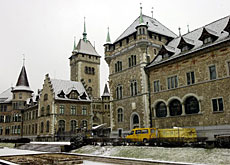Museums proposal rejected by parliament

A proposal to change the Swiss National Museum into a foundation has run aground in parliament ending four years of discussions.
The House of Representatives followed the Senate in rejecting the restructuring plans, calling instead for a review of all 15 state-run Swiss museums.
There was cross-party recognition of the importance of the national museums in parliament on Tuesday.
But an overwhelming majority in the House wanted the newly-appointed heads in the Federal Culture Office to first produce a clear strategy and objectives for managing the Musée Suisse Group comprising eight museums across the country.
Over the years, the federal authorities have taken charge of the institutions, which are charged with preserving Switzerland’s heritage.
After much delay, in 2002 the government presented a plan to make the national museums more autonomous and efficient, transforming the Musée Suisse Group into a foundation.
However, after dragging on for more than four years, the plan lost much of its original support, with the Senate rejecting it last December.
Lack of interest
In the absence of a clear strategy for national museums, the Musée Suisse Group has become a hotchpotch of cultural institutions without a clear sense of purpose, critics say.
Responsibility for the state’s museums is divided between five government ministries and 11 federal offices.
“Unlike many other European countries, Switzerland has not yet come up with a viable policy for its national museums. This probably reflects a lack of interest on the part of politicians and a failure of initiative on the part of the federal administration,” says Hans Wehrli, chairman of the Swiss National Museum Committee.
This lack of interest has, among other things, considerably delayed the work of modernisation and enlargement.
Even the National Museum in Zurich, which houses the largest collection or artefacts in all of Switzerland, had to wait until the end of 2005 for work to begin on the first programme of restoration in its 100-year history.
In the 1990s, a number of decrepit rooms had to be closed for safety reasons. There has also been delay in building a new exhibition area for the 20th-century collection, which languishes in the basement.
Closed for safety reasons
Also on Tuesday, the House of Representatives has called for greater urgency in building the planned extension to the Zurich’s National Museum. The project, approved by the government four years ago, is intended to fill a major gap.
Swiss history, as recorded by the national museums of Zurich and in the village of Prangins in western Switzerland, stops at the end of the 19th century.
“The museums do not cover the most recent period, with which the Swiss feel a closer connection. People would like to know, for example, what happened during the Second World War, or how Swissair came into being,” explains Hans Wehrli.
Another factor hindering development of the national museums, which come under the Federal Culture Office, is their lack of autonomy.
“Every important decision has to be approved by Bern. And you may have to wait 13 weeks to get a reply to a letter,” complains Regula Zweifel, deputy director of the National Museum.
swissinfo
Almost half a million people visit the Musée Suisse Group museums each year.
Every year the federal authorities spend around SFr35 million to keep the national museums up and running.
State funding covers 90% of the management costs. Entrance fees account for just 10% of the museums’ income.
With 1000 venues featuring its history, culture and scientific achievements, Switzerland has the highest concentration of museums in Europe.
The federal authorities manage 15 museums, eight of which form the Musée Suisse Group.
The two largest institutions are the Swiss National Museum in Zurich and the Castle of Prangins, which house over one million historical exhibits, ranging from early times to the end of the 19th century.
The other six museums are devoted to areas of special interest.

In compliance with the JTI standards
More: SWI swissinfo.ch certified by the Journalism Trust Initiative










You can find an overview of ongoing debates with our journalists here . Please join us!
If you want to start a conversation about a topic raised in this article or want to report factual errors, email us at english@swissinfo.ch.